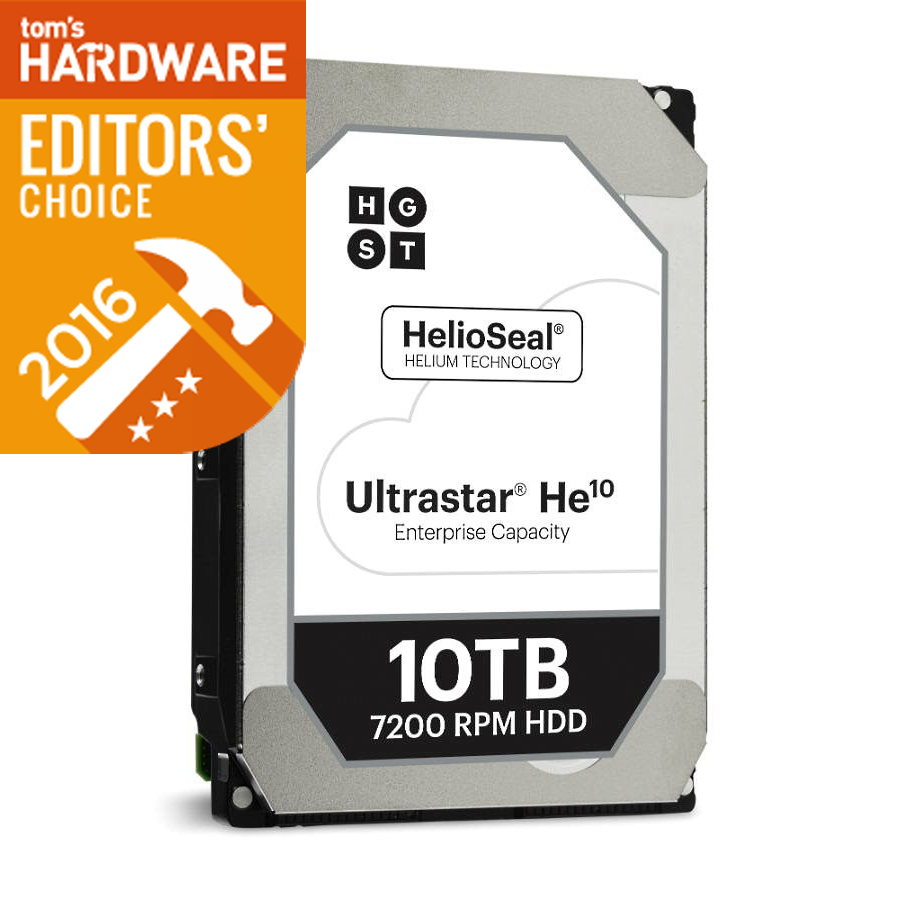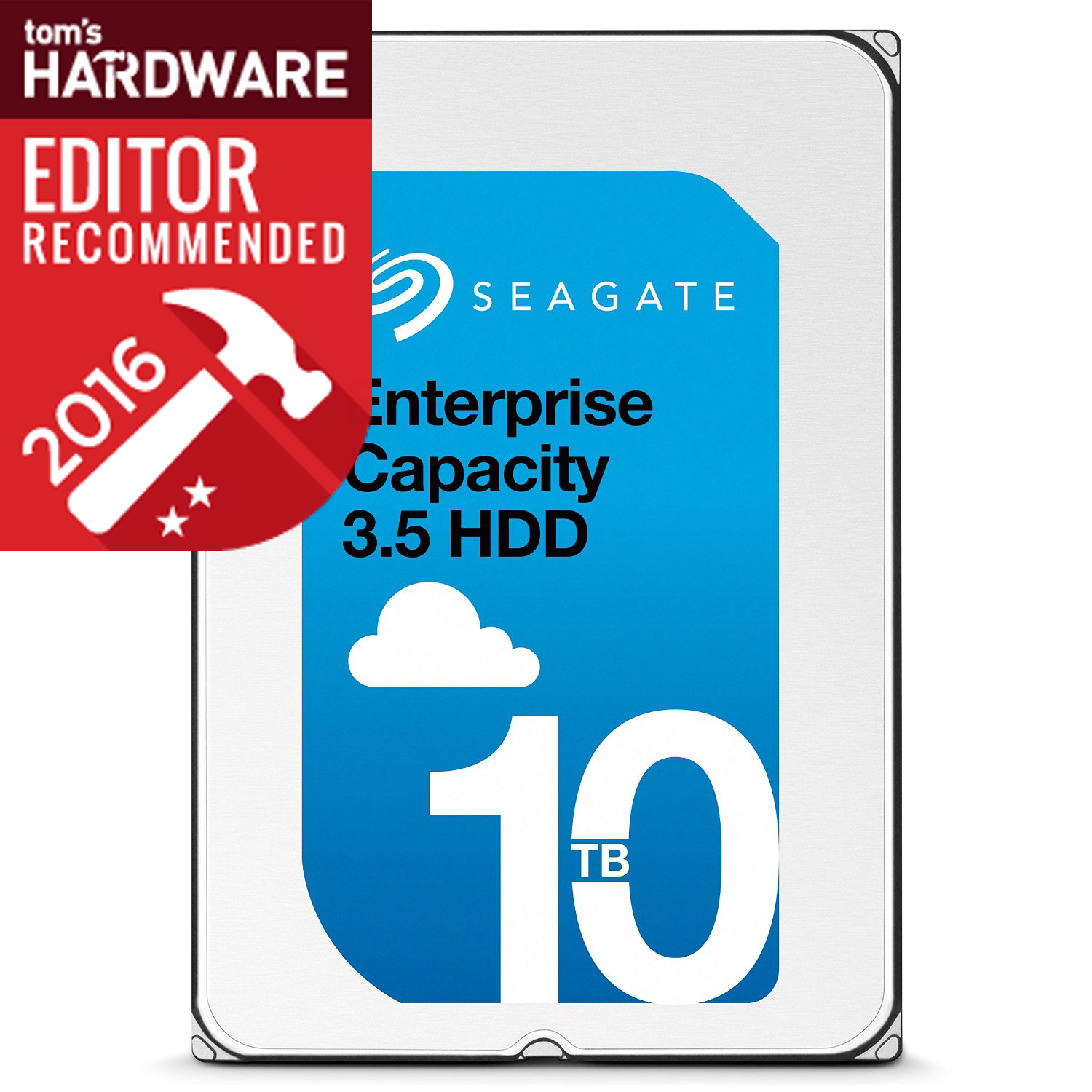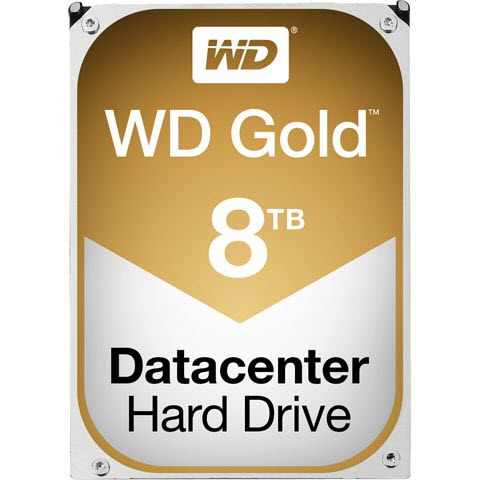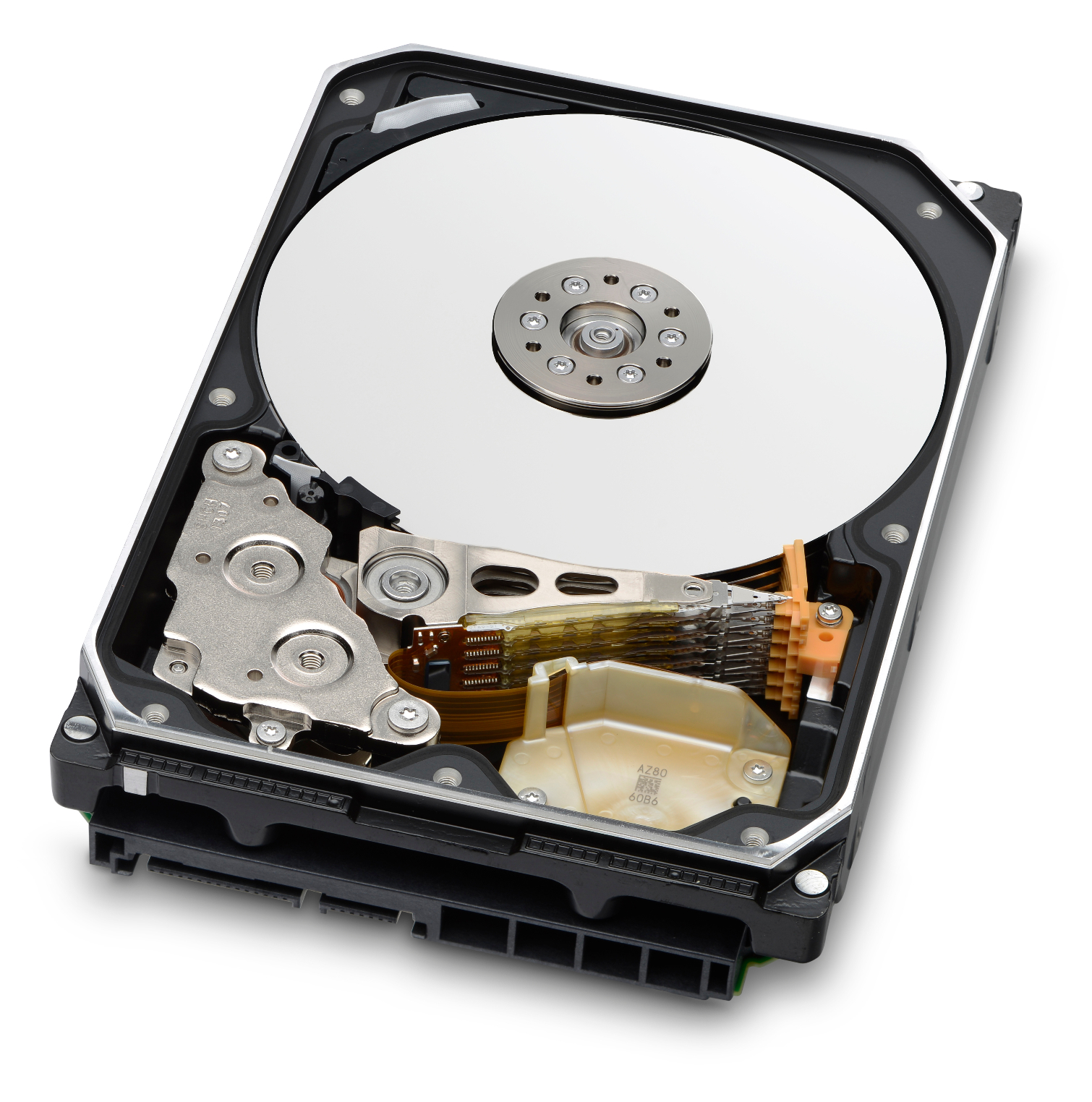Big HDD Showdown: Seagate 10TB vs. HGST Ultrastar He10 vs. WD Gold 8TB
Analysis
Why you can trust Tom's Hardware
HGST led the market to helium and media caching techniques, and its innovator status has given it more experience with the platform, which bled through during our testing. The HGST Ultrastar He10 offered the best mix of performance and power consumption, especially in light of its SAS connection, in comparison to the competing HDDs. To the untrained eye, the lower performance under the heaviest of workloads will appear to be a disadvantage, but HGST obviously tuned its He10 to offer the best performance under light workloads, which is going to be the prevalent use-case (particularly in RAID and other distributed architectures, such as object storage environments).
HGST Ultrastar He10
The He10 provided a solid performance profile during mixed random workloads, though it ceded a bit of the read-centric workload performance during the 8K mixed random test. The drive and its WD Gold 8TB cousin experienced some variability in the write-centric random workloads, but these would be rare in a performance-optimized application, and almost non-existent in the modern definition of a nearline HDD workload. During mixed sequential testing, the He10 offered a tangible performance increase across the board. The drive also has a proclivity for light sequential workloads, which makes it well suited for its intended environment.
HGST Ultrastar He10
Reasons to buy
Reasons to avoid

Seagate Enterprise Capacity 10TB
The Seagate Enterprise Capacity 10TB offered a solid mix of performance and power consumption that easily outstripped the WD Gold 8TB, but lagged slightly behind the HGST He10, in particular during the important mixed sequential workloads. The Seagate 10TB held the lead during random read workloads, particularly during lighter sections of the test, and it also provided a better performance profile during the 8K mixed random workloads. The role of the nearline HDD in the data center is migrating more towards bulk storage, or as large storage pools that SSDs accelerate with caching or tiering. Random performance is important in some workloads, but the real litmus test for the broader audience is with the sequential performance. The Seagate 10TB trailed the HGST 10TB HDD for many of the sequential tests; though it did weather the heavier sequential write workloads better.
The SATA Seagate 10TB also offered the lowest power consumption of the test pool, but that can be somewhat misleading due to the 12Gb/s SAS interface on the He10. The Seagate 10TB offers a huge reduction in power consumption over the previous generation air-based Seagate model and packs 2TB of extra storage, which is an impressive accomplishment in its own right. The SATA version of the He10 will likely match or beat the Seagate 10TB in power consumption metrics, but they should be comparable enough to push the conversation to other factors, such as which drive either fits the intended use case better or the price of the respective solutions.
Seagate Enterprise Capacity 10TB
Reasons to buy
Reasons to avoid

WD Gold 8TB
The WD Gold 8TB is clearly a near copy of the HGST He8, but it does have its unique characteristics, some of which result in lower performance during server workloads at lighter queue depths. The WD Gold was able to write the full span of its platters slightly faster than the He8, and it features very similar power consumption and performance metrics compared with the HGST He8. However, I can see no reason to purchase the WD Gold 8TB above the HGST He8, and the Seagate 8TB clearly outclasses them both in almost every aspect of performance, though it certainly requires more power to do so.
WD indicated that it is employing similar technologies across both WD and HGST products, which includes mechanical components, electronics and firmware, which was clear during our testing. WD is mass-producing its 8TB drives now, but the company will release 10TB HDDs based upon the HGST He10 design shortly. The MOFCOM regulations will not allow the two companies to merge their product lines for another 15 months, but it’s a safe bet that when the time comes, the two companies will already have nearly identical products.
WD Gold 8TB
Reasons to buy
Reasons to avoid

Pricing Comparison
| Price | Low | Average | High |
|---|---|---|---|
| Seagate Enterprise Capacity 10TB | $588 | $615 | $662 |
| HGST Ultrastar He10 10TB | $500 | $686 | $809 |
| WD Gold 8TB | $545 | $592 | $642 |
| HGST He8 8TB | $368 | $472 | $549 |
| Seagate 8TB | $389 | $431 | $505 |
We base our pricing comparisons upon retail pricing, and it is valid only at the time of publishing. Multiple vendors carry the drives, and pricing varies based on supply and demand, so there can be significant price swings over time. Retail prices are also a far cry from the volume discounts offered to Tier 1 OEMs and hyperscale data centers. In many cases, the decision will come down to either the cost of the drive or which drive the OEM supports.
The Seagate Enterprise Capacity 10TB surprisingly features a much lower average price than the He10, but this may be due to heavy demand for the HGST drive, which retails for $800 at several e-tailers. The HGST He10 is more power miserly and faster than the Seagate Enterprise Capacity 10TB in the metrics that matter, but if Seagate continues to leverage a low price structure it will certainly find plenty of success as well.
The low average price and the stellar performance of the Seagate 8TB explain why it is such a popular drive, and though the competing WD Gold and HGST He8 are more power efficient, it would likely take time to recoup the big gulf in pricing between the products. The higher price of the WD Gold will certainly price it out of the majority of contests, but jumping the pricing hurdle requires high-volume sales, so as WD sells more drives we expect prices to decline.
The promise of helium boils down to reduced power consumption and cost, along with increased performance and efficiency. In some cases, there are small differences between the helium-based drives, but all of them easily outclass their air-based predecessors in several key metrics. The industry is embracing helium, so it is the clear path forward to increasing density with standard PMR, and the architecture will become even more exciting when vendors pair it with future recording techniques.
MORE: Best Enterprise Hard Drives
MORE: Best Enterprise SSDs
MORE: How We Test Enterprise SSDs
MORE: How We Test Enterprise HDDs
Follow us on Facebook, Google+, RSS, Twitter and YouTube.
Get Tom's Hardware's best news and in-depth reviews, straight to your inbox.

Paul Alcorn is the Editor-in-Chief for Tom's Hardware US. He also writes news and reviews on CPUs, storage, and enterprise hardware.
-
Bret_Schumacher You should have compared it to the 10TB gold which had "supposedly" higher read/write rates comparable to seagate and hgstReply -
Paul Alcorn Reply18389500 said:You should have compared it to the 10TB gold which had "supposedly" higher read/write rates comparable to seagate and hgst
I agree. The 10TB Gold was only announced two days ago. We inquired with WD, but samples are not ready yet.
-
AndrewJacksonZA I know that your review uses the pricing that you have at hand, but as I'm reading the article, your ads are displaying prices as follows:Reply
HGST ULTRASTAR HE10 - $506 on Amazon
SEAGATE ENTERPRISE CAPACITY 10TB - $589 on Amazon
WD GOLD 8TB - $600 on Newegg
The HE10 in the review is taken as the most expensive drive when it's actually the cheapest. Would you consider revising your pros and cons for each drive's cost?
Thank you -
Paul Alcorn Reply18389599 said:I know that your review uses the pricing that you have at hand, but as I'm reading the article, your ads are displaying prices as follows:
HGST ULTRASTAR HE10 - $506 on Amazon
SEAGATE ENTERPRISE CAPACITY 10TB - $589 on Amazon
WD GOLD 8TB - $600 on Newegg
The HE10 in the review is taken as the most expensive drive when it's actually the cheapest. Would you consider revising your pros and cons for each drive's cost?
Thank you
Prices fluctuate, and it varies between retailers. Usually we do not provide a graph with low, average, and high values, but I added it due to the big price variation between retailers. It isn't a perfect system, but retail pricing is our only resource.
The $500 for the HGST He10 is noted in the 'low' category, but the drive is still retailing at CDW for $855.
-
3ogdy Reply18389819 said:No Seagate for me. Their drives are notoriously unreliable and always fail on us.
THERE.YOU.GO. Once again another one just like me...
Seagate hard drives have proven to be extremely unreliable for me too. This company is an absolute nightmare. I have quite a few 7200.12 500GB and 7200.14 2TB Barracudas that simply stopped working. Some of them, in a very convenient way, right after the 2yr warranty - even though that doesn't cover data recovery, of course.
Once my last 7200.14 2TB Barracuda went belly up...I had to cough up over $1000 to ship that POS to the Netherlands and have my data sent back to me on an external Seagate drive. VERY poor quality products from this company. I'm terrified at the thought of using anything from Seagate to store my data on. I lost countless projects, personal data and things I needed, but Seagate isn't gonna get a copulating cent from me anymore. I'm not touching anything coming from them and they can easily rest assured none of my clients EVER will.
Another detail I'd mention is this: I was on the phone with a Seagate representative and I told them how everything happened (well, basically my partitions were not there in Windows, the drive didn't show up under Device Management...). I'm asked for a serial number and then I'm told: You've just lost your warranty on your Seagate product. (it was legally under warranty that I could have claimed through the shop I got the drive from)
EXCUSE ME?
Very bad customer experience - building HDDs to get people to call on you for data recovery and pay over 15x the price of your POS product in order to get their data back. Your business model is not focused on providing reliable storage systems ( HDDs ) - you're not an HDD manufacturer at heart - you're a data recovery company.
WELL DONE WE'RE DONE, Seagate.
Also, shall I mention there's a class action suit being prepared against Sh*tgate at the EU level?
HGST (WD subsidiary) has proven much more reliable throughout the years and they also provide a 5 years warranty (data recovery not included, of course).
P.S. NEVER provide your HDD's serial number to Seagate on the phone.
The lesson I'm teaching everyone I can around me is NEVER EVER trust your data to Seagate. NEVER use Seagate products as they don't stand by them and are only interested in making your pockets lighter. Even friends who weren't aware about this company now know what to avoid in their systems.
Whenever you have to choose storage - consider SSDs first and if capacities don't fit the budget, pick something more reliable from either HGST, WD...I can't really speak for Toshiba drives but I doubt they're as problematic as Seagate's I rememebr reading Backblaze's reliability reports and thinking : It all makes sense to me now. People said they hadn't tested Seagate drives properly and that their technique was flawed, but they were right. -
RedJaron Paul, any chance you or Chris R might review a basic consumer spindle drive soon? I know they're not the "sexy" thing right now with new SSDs and high-capacity enterprise storage getting released. But considering most consumer builds still include a TB or two of spindle storage, I'd be interested to see if there have been any significant advances in the last 3 - 5 years. In particular, the WD Blue 1TB is 7200 rpm while the 2TB model is 5400 rpm. Is 5400 still a curse word in today's spindle drives?Reply -
Paul Alcorn Reply18390300 said:Paul, any chance you or Chris R might review a basic consumer spindle drive soon? I know they're not the "sexy" thing right now with new SSDs and high-capacity enterprise storage getting released. But considering most consumer builds still include a TB or two of spindle storage, I'd be interested to see if there have been any significant advances in the last 3 - 5 years. In particular, the WD Blue 1TB is 7200 rpm while the 2TB model is 5400 rpm. Is 5400 still a curse word in today's spindle drives?
There is actually something in the pipeline right now, so we should have something for you soon(ish). I am not sure about the test pool yet, but those are good suggestions. :)
-
logainofhades I really want 2x8tb drives for a Raid 1 setup, but the cost is still too high. :(Reply
